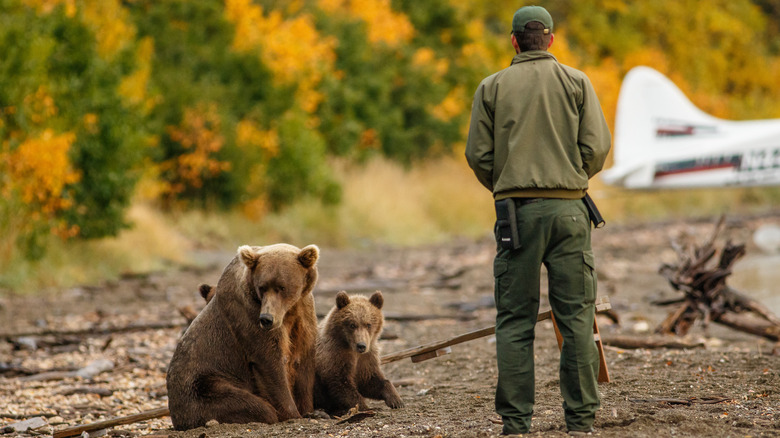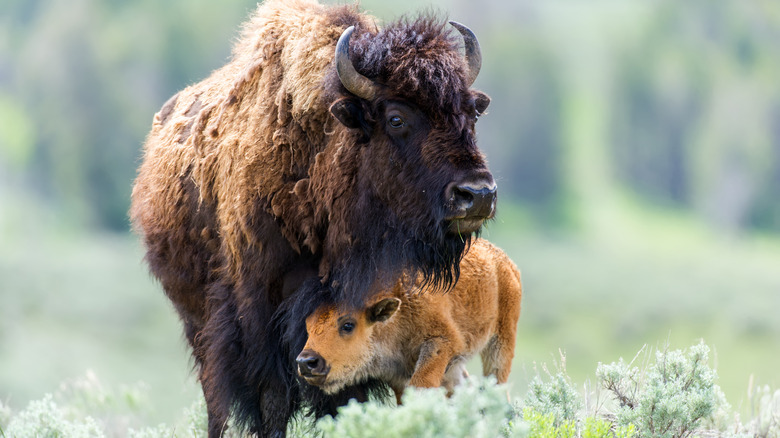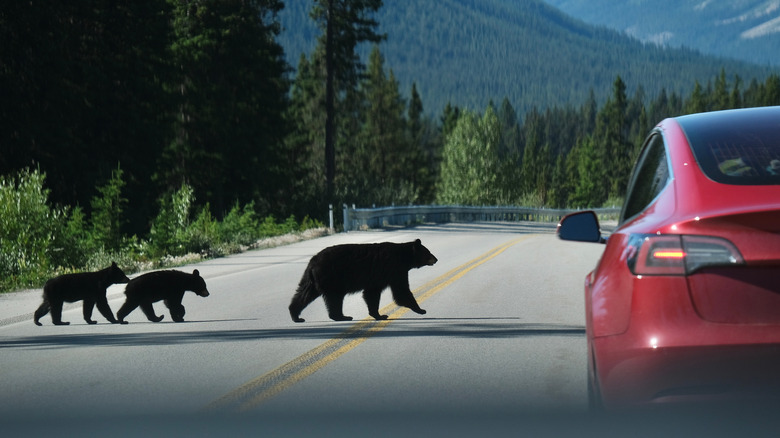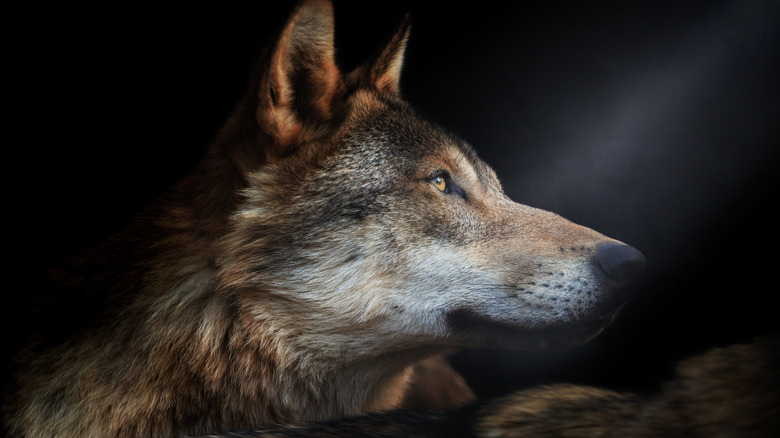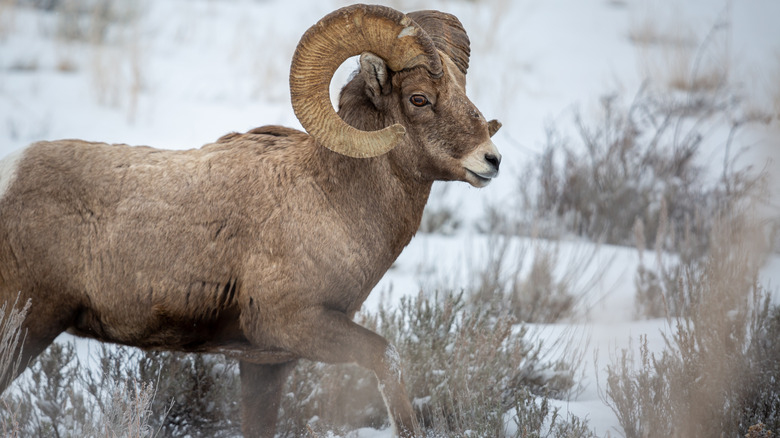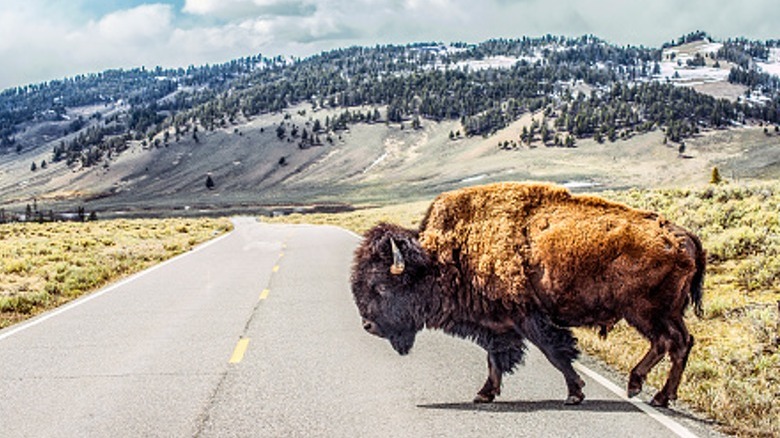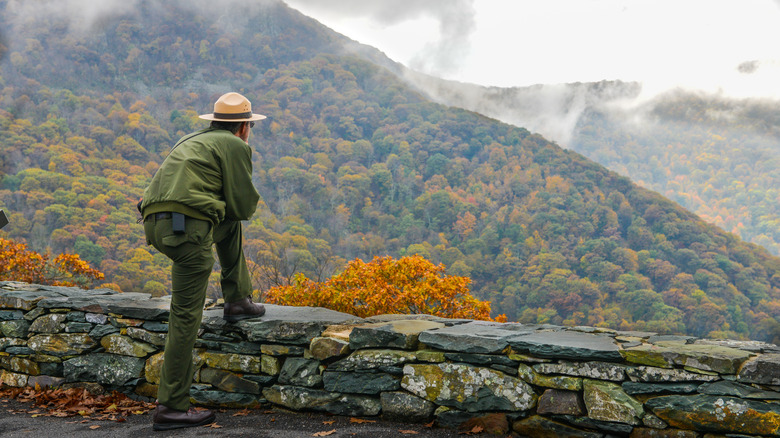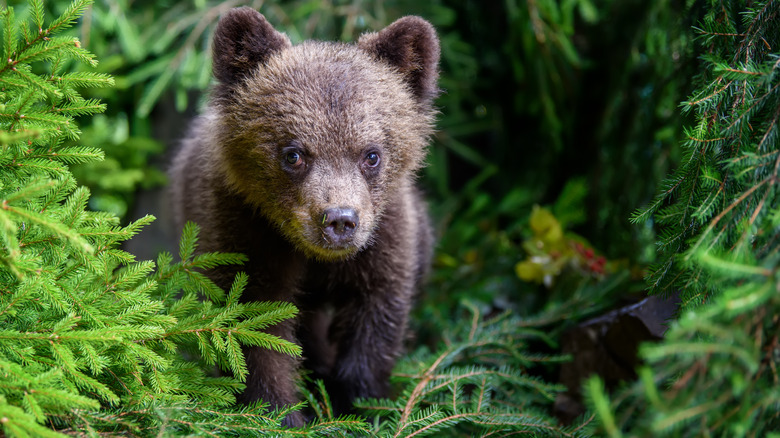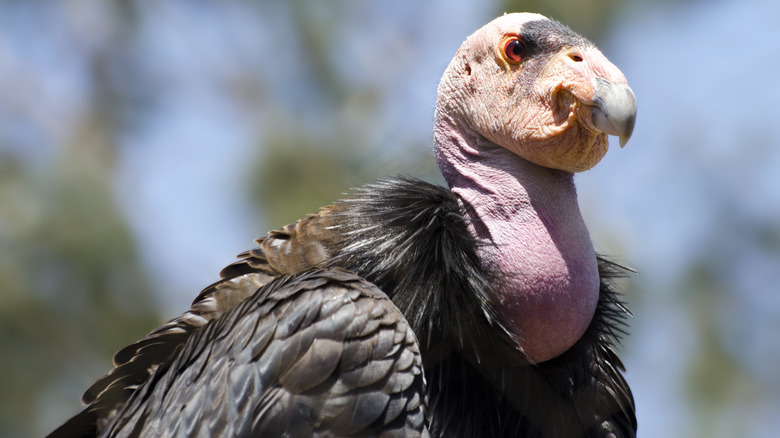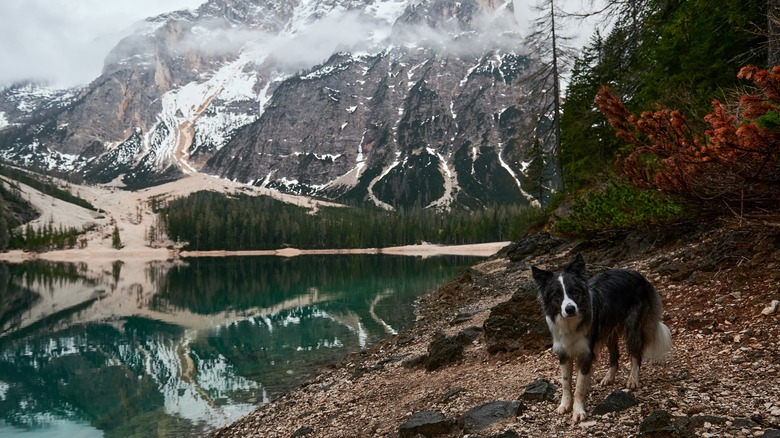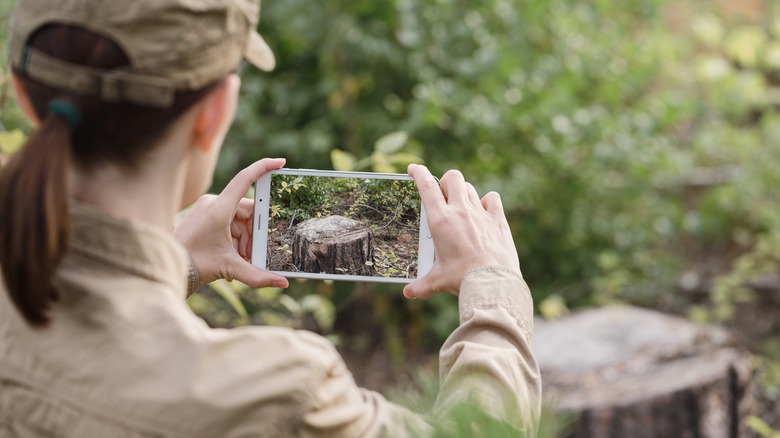Rules Park Rangers Have To Follow In National Parks
Being a park ranger seems like it would be super fun. Where else would you get paid for going hiking, seeing some of the most majestic animals in the country, and exploring the wilds of nature with no boss looking over your shoulder, wondering if you're really just playing a game on your phone when you're supposed to be working? Sounds pretty awesome, right?
As with many too-good-to-be-true professions, there's much more to being a national park ranger than just hiking around and keeping an eye on the animals. There's a lot of really serious stuff involved, like trying to figure out a way to lessen collisions between cars and wildlife and reduce the too-high number of animals that end up as roadkill in the nation's national parks. So ... maybe not so much fun.
According to the National Park Service (NPS) Organic Act of 1916, the NPS has a very specific purpose, and that's to "conserve the scenery and the natural and historic objects and the wildlife [in national parks], and to provide for their enjoyment in such manner and by such means as will leave them unimpaired for the enjoyment of future generations." The agency's rangers have an uphill battle ahead of them, and sometimes they have to make life-or-death decisions. And even though there are rules in place to guide those choices, they're still difficult ones to make.
Euthanize animals that pose threats to visitors
In 2023, the nation was taught an important lesson when Yellowstone National Park released a photo of a visitor who was pulling a young bison from a river and asked for help in identifying the man. After the incident, the calf was rejected by the herd and euthanized after being spotted approaching cars.
The man came forward when he heard authorities were looking for him, saying that he'd seen the calf drowning and tried to save the poor thing. He was handed a relatively minor fine, and reminders were issued again ... just as they had been back in 2016, when visitors put a bison calf in the back of their SUV because they thought it was cold. That calf was euthanized too, and the official statement from the park (via ABC News) is where the rules come in. Both calves were euthanized for the same reason: Each animal was presenting a very real danger to people — one that would only keep getting bigger.
Bison can be scary, but they're not the scariest of a national park's animals; rangers have also had to kill bears that threaten visitors. Rangers in Alaska's Kenai Fjords National Park killed a black bear in 2021 after it was reportedly getting too close for comfort. Here's a question: Why not rehome them? They're supposed to protect animals, right? Yellowstone spokesperson Charissa Reid explained why the rule is there: "We're not in the business of animal rescue."
Euthanize animals that are in pain
When visitors to Yellowstone National Park put a "cold" baby bison in the back of their SUV to drive it to a park facility, the calf was euthanized. Spokesperson Charissa Reid explained that it happened, in part, because of the life the poor thing was destined to live. "It was just a very inhumane situation. The calf was either going to starve to death, get sick, get hit, or cause an accident, so we had to make the difficult decision to put it down," she explained (via ABC News).
Taking a hands-off approach to dealing with wildlife and letting them just be wild — for better or worse — is obviously the first choice, but part of what national park rangers have to do is end the suffering of animals who are in pain. And it's never pleasant.
In 2021, rangers in Glacier National Park were forced to euthanize an otherwise healthy bear that had been hit by a car. The bear suffered massive injuries and — since the driver didn't report the accident — laid in the road for a bit before rangers arrived on the scene. It's also worth noting that anyone who's in a national park and is involved in an accident with wildlife must — by law — report it. Thankfully, that's what motorist Jeff Nelson did in May 2023 when he hit two bison on a foggy night in Yellowstone. Rangers euthanized both animals due to the extent of their injuries, according to Cowboy State Daily.
Allow the hunting of their animals outside of their territory
Animals don't see boundaries the way people do, and it's arguable that it's just one more way they're better than humans. Unfortunately for them, it can also turn deadly very quickly — particularly for wolves.
Wolves have had a rough few decades, alternately being hunted to near-extinction, reintroduced to parks like Yellowstone, and then having their protections removed. That's what happened during Donald Trump's presidency, and although a 2022 federal ruling restored some of the regulations that protect wolves, that wasn't the end of the story. When The Washington Post did a deep dive into the issue of wolves vs. hunters, they found it was incredibly complicated, with passionate people on both sides. The part that's relevant to the rules that national park rangers have to operate inside is that if a wolf that typically lives on national park land — and, in most cases, is being tracked and monitored — wanders off into state land, park rangers have to allow it to be free game.
Red states in particular have gone after wolves hard with legislation that Yellowstone superintendent Cam Sholly called "highly concerning to [park officials]." Yet they have little recourse but to sit and watch: Wyoming, for example, allows the hunting of wolves across about 85% of the state, and in 2021 and 2022, Montana's governor shot and killed a wolf and a mountain lion, respectively, that were both being tracked and monitored by the National Park Service.
Participate in culling operations
Love animals? Never want to hurt one under any circumstances? Don't become a park ranger. As Point Reyes National Seashore outreach coordinator Melanie Gunn confirmed to Bay Nature, "Lots of National Park Service units do removal of wildlife, and they do a kind of full range of options." In other words, sometimes they do it themselves, and sometimes they oversee outside contractors who cull animals by the numbers they've determined have to go.
Park rangers carefully monitor populations, and when numbers get too high, they must decide how many animals have to die to maintain a healthy balance. In 2012, Rock Creek Park chief ranger Nick Bartolomeo explained to The New York Times that rangers were resorting to using sharpshooters to kill deer that were so numerous they were destroying the ecological balance of the park and spilling over into the streets of Washington, D.C. If it seems like deploying sharpshooters in a densely populated area would get some pushback, it absolutely did — but Bartolomeo added that the rangers had to abide by so many regulations that by the time they came up with a solution, it was all they had left.
Different parks have different problems. In 2021, rangers oversaw volunteer teams culling non-native mountain goats from Grand Teton National Park, and in 2023, federal rangers in Gila National Forest were going to be pulling the trigger themselves — from helicopters. After going through all the proper channels, rangers were given federal permission to shoot and kill up to 150 semi-feral cattle on park property.
There are guidelines for disposing of dead animals
Seeing a majestic herd of bison moving through the wild lands of a national park might be the kind of thing that can move a person to tears, but the circle of life can be a cruel thing — especially for animals. So, what happens when some of these massive beasts move on to whatever comes after this life? There's actually a set of rules that dictate how rangers deal with remains. In the best case scenario, they leave them right where they fall. There, the carcasses will provide food for everything from scavengers to bacteria, but that's not always possible.
In some cases, they need to be moved away from populated areas, and it's up to the rangers to drag them to a remote spot so they won't attract those scavengers to an area frequented by guests. The same rules apply for roadkill: When a visitor hit two bison in Yellowstone in 2023, rangers had their work cut out for them — they had to drag the two massive animals out into the deep wilderness.
There's another scenario, too. According to what Frank Durbian of the National Elk Refuge told Bay Nature, some animals will be tested for disease, especially if they appear sick. If disease is detected, the remains are incinerated, and if it's not, they're dragged back out into the forests where they can make a natural return to the world around them.
There are a slew of events national park rangers have to report
National park rangers are law enforcement, and as law enforcement, there are a slew of procedures and protocols for things like the use of force. They're outlined in a heavily redacted version of the National Park Service Law Enforcement Program Reference Manual, and a lot of it is fairly standard. There is some pretty interesting stuff buried in what's publicly available, though, and that includes rules about filing reports with the NPS's Serious Incident Reporting System. It's basically how they keep track of things like deaths, criminal activities, and accidents ... and not all incidents are treated equally.
First, there are high-priority incidents, and rangers must report these immediately. They include things like injuries or deaths to park employees or other government officials, major crimes (including assault and weapons felonies), drug-related crimes, dog bites, disasters (including natural disasters and man-made ones, such as forest fires), and the discovery of a wildlife mortality incident (like a mass die-off).
That all makes sense — those are very important things, after all. But here's something that's a little more surprising: In addition to these high-priority incidents, there are also incidents that are considered "normal," which means rangers have three days to submit their report. First on the list? "Non-employee fatalities." It goes on to specify that "visitor or public fatalities" are considered normal priority, along with suicide attempts, wildlife attacks, search and rescue operations, and public health incidents.
Don't rescue injured or orphaned animals
It's safe to say that many people might want to get involved with the National Park Service because they love animals and want to protect the country's vast — but ever-endangered — wilds. That's admirable, but there's a massive catch: Anyone who wants to be a ranger has to be all right with seeing an orphaned baby animal and leaving them right where they are. Heartstrings tugged by Bambi? Want to lend a helping hand? Rangers have to walk the other way.
Wondering how the heck that's policy? Many people do, and the NPS has explained why rangers at parks like Yellowstone do not rehabilitate or rescue injured adults or orphaned babies. Part of it is simply to preserve the integrity of the natural world: Nature is, after all, messy and often cruel, and sometimes young animals are going to get hurt or die — that's just how it all works. Interference by rangers can upset the natural balance, and it can be the difference between an area that's as wild as possible and a sort of free-range zoo.
Wildlife rehabilitation is also an expensive venture that takes not only money, but time, space, specialized veterinary care, and resources that could be applied to more wide-reaching programs, as opposed to trying to save a single animal that might or might not survive. Cold? Sure. Hard to watch? Absolutely. But necessary? Yes, it's that, too.
Follow specific guidelines about specific species
The life of a national park ranger can be pretty, well, wide-ranging, and depending on the park and its needs, rules can change drastically. At the heart of it all is the ideology that forms the basis of all park rules: Conserve the plants and animals that call that park home. That means different things for different parks.
In some parks — like Yellowstone and Glacier National Park — that means rangers have to make the best decisions they can to minimize interaction between bears and visitors, and take whatever precautions they feel are necessary. In 2019, for example, that meant enforcing a series of closures and reopenings of individual campgrounds where bears had been spotted. Priorities have shifted over the years since the establishment of national parks, too: In 2017, NPR spoke with Yosemite rangers who said that the ways in which they dealt with bear-people contact had changed. Previously, it often meant the death of the bear, but conservation efforts now have shifted rangers' duties to focus more on catch-and-release.
In other parks, rangers have to focus on other priorities. In some parks — like Kentucky's Mammoth Cave — it's the area's bat population that gets extra-special consideration. Grand Canyon National Park rangers focus on their California condors (pictured), while some parks — like the Golden Gate National Recreation Area — have endangered plants high on their list of concerns.
Different K9 units have different rules
National park rangers work with canine officers in a variety of capacities. A much-redacted, publicly accessible version of the National Park Service's Reference Manual outlines some of the rules rangers must follow if they have a dog. It involves some standard stuff, like being responsible for record-keeping, making sure the dog has regular vet care, and being familiar with the dog's capabilities. Now, on to the cool stuff.
Park rangers use their dogs in different ways. Some might be trained to find sea turtle nests, some can detect invasive species, and there's even a group of border collies that work to keep Canadian geese away from national parks in Washington, D.C. (Border collies also work in places like Glacier National Park, helping wild animals stay away from people.) Chasing geese is pretty much a border collie's definition of a good time, but not all park dogs have such fun jobs.
Some dogs work alongside their human counterparts in historical parks, detecting guns and explosives in crowds of people, while others work as drug-sniffing dogs to ferret out everything from drug smugglers to meth labs. Others, of course, work as search-and-rescue dogs, and in some cases, the dogs have to regularly renew certifications or take additional training courses — and it's up to the rangers to see that their dogs meet all the legal requirements to work alongside them. (And yes, when the dogs retire, their handlers have the option of keeping them.)
Be in really good shape
In 2005, NPR took a look at some of the things national park rangers had to face on a regular basis, and it was pretty eye-opening. Yosemite ranger Leslie Reynolds described visitors armed with "firearms, knives, switchblades, [and] nunchakus," while colleague Grady Bryant rattled off a list of incidents he had dealt with, including felonies and violent crimes. National parks can be dangerous places, so it's no wonder that one of the most important safety rules rangers have to follow is to be in pretty good shape.
When prospective candidates apply for law enforcement positions within the National Park Service, they have to take the Physical Efficiency Battery and meet the requirements laid out by the NPS. Interested in a seasonal position? Take and pass the test. Already a part of the NPS, and want to be a ranger? Take and pass the test. It's extensive, and includes a 1.5-mile run, sit-and-reach flexibility tests, a bench press, an agility course, and a body composition test.
The standards are high, but they have to be. At the time of NPR's report, Kirk Gebicke was one of only four rangers tasked with patrolling the 1.6 million-acre Mojave National Preserve. He explained: "You don't get into anything you can't handle yourself because there is no backup. If we called for backup right now, it would be [an] hour, hour and a half, if somebody had a vehicle and knew where I was."
